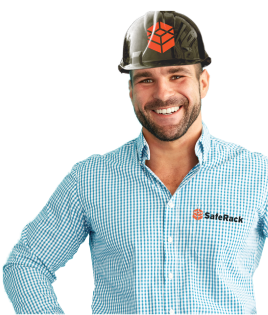34′ Stair Tower Installation

This is a customized ErectaStep stair tower installation. With a height of 34′ feet, this stair tower is for contractors, maintenance staff, and researchers to frequently access the roof at an HVAC R&D facility in Atlanta. This installation also includes a jib off to the side to safely hoist tools and small equipment up to the roof.
Millions of workers located all over the world use ladders every day to perform a broad range of tasks. Ladders are not only unsafe, their use negatively impacts worker productivity. According to the Bureau of Labor Statistics, 1/7th of all fatal fall injuries involve the use of ladders. Unsafe stairways and scaffolding platforms also contribute to fatal and serious workplace injuries.
Stair towers that comply with OSHA regulations incorporate many safety features in stair parts, such as railings and anti-slip surfaces, that protect workers from sustaining serious injuries. Moreover, a stair tower can also greatly improve productivity since they grant workers greater freedom of movement, allow multiple workers to use them simultaneously, and allow work crews to supply scaffolding platforms faster to minimize downtime.
What is a Stair Tower?
A stair tower is a fixed structure that consists of more than one flight of stairs. Stair towers are utilized in industrial settings by workers to improve efficiency and keep them safe. Stair towers that are not accessible to the public are covered by the Occupational Safety and Health Administration’s (OSHA) Fixed Industrial Stair Regulations (1910.24). These regulations govern the design, construction, and use of stairs that give workers access to equipment or machinery, other floors, and elevated platforms.
Public stairways are subject to International Building Code (IBC) regulations to ensure the safety of every person utilizing the stairs. Like OSHA, IBC regulations govern the design, construction, and use of stairs in commercial applications.
Key Stair Tower Safety Features
To meet OSHA requirements and to ensure workplace safety, stair towers should be designed and constructed to incorporate certain key safety features.
Strength and Precision
OSHA regulations require stair towers to be designed to carry a load that is 5 times greater than the anticipated load, with a minimum load of 1,000 pounds. Moreover, handrails and guardrails must be able to withstand at least 200 pounds of pressure applied in all directions. Stairs must be a minimum of 22 inches wide and tread measurements are dictated by the angle of the stairway rise. For instance, a 45-degree stairway must offer a minimum rise and tread of 8.75 inches each.
ErectaStep stair towers are made to precise specifications using high-grade aluminum. We use patented design processes that incorporate durable powder-coated handrails and laser-cutting technology to ensure superior strength, durability, and quality.
Slip Resistant
OHSA 1926 provides that slippery conditions on stairways must be eliminated “before the stairways are used to reach other levels.” ErectaStep stair towers feature anti-slip surfaces built into every stair tread and platform to ensure the highest level of safety and compliance.
Handrails and Landings
In addition to outward pressure requirements, handrails must meet certain height requirements. OSHA requires that the top rail be at least 42 inches in height while the handrail must be between 30 and 38 inches in height – measured from the leading edge of the stair tread to the top surface of the rail.
OSHA 1917.120(b)(2) states that stair landings must offer at least 20 inches in depth. If a door or gate opens on the stairway there must be a landing platform and the door swing cannot reduce the effective standing area on the landing to less than 18” in depth. ErectaStep stair towers incorporate railings, handrails, and landings that comply with OSHA specifications to maximize worker safety and productivity.
Stair Tower Benefits
A stair tower can yield enormous benefits. At the individual level, workers are kept safe and given freedom of movement to perform their jobs more comfortably and efficiently. For organizations, a stair tower can increase productivity and revenue, reduce costs, and protect employers from stiff OSHA fines and potential lawsuits. More specifically, ErectaStep stair towers:
- Make scaffolding more accessible and safe
- Eliminate risks associated with ladder access
- Give workers a quick means of evacuation during emergencies
- Can be customized to reach various heights, overcome space constraints, and meet your application for less than the cost of other custom-engineered solutions
- Are maintenance-free
- Provide non-skid surfaces to ensure worker safety
- Include strong and smooth handrails for ease of use
- Allow workers to safely raise materials to work platforms
- Are suitable for use in both indoor and outdoor environments
- Can include secured enclosures and safety exit doors
- Install fast without the use of cranes and other special tools
- Are made of aluminum which means they will not rust, rot, or warp
- Meet all OSHA regulations to ensure a safe and compliant workplace
ErectaStep: Prefabricated and Custom Stair Tower Solutions
ErectaStep offers a full line of OSHA-compliant industrial metal stairs and maintenance access platforms. These solutions are not only cost-effective but are easy to assemble. Prefabricated metal stairs bolt together in a snap without the need for welding or special tools. ErectaStep also offers IBC compliant commercial prefabricated metal staircases.
→ Know the difference between OSHA and IBC compliance
ErectaStep also makes it easy to design a custom stair tower. We utilize state-of-the-art tools that will provide you with custom detailed drawings and quotes in a matter of minutes. For more complicated applications, our experienced team will work with you to design the perfect solution.
Our team recently completed this design, build, and installation of a 34’ tall PSTEP stair tower system at an R&D lab facility located in Atlanta, Georgia. The lab sought a safe and efficient solution that would give workers access to the roof to service HVAC equipment and perform a broad range of weekly tasks. The stair tower allows maintenance staff and contractors to access the roof without using ladder access through the roof and also makes it simple to transport tools and materials safely.
Contact our team today to discuss the perfect prefabricated or custom OSHA-compliant metal stair tower for your organization.



